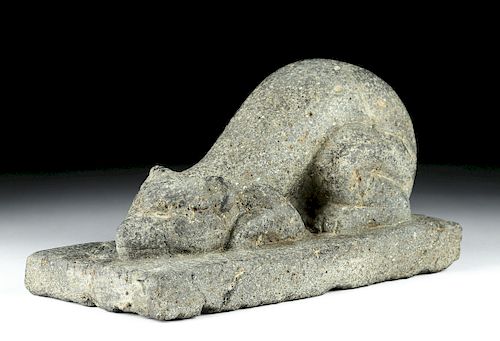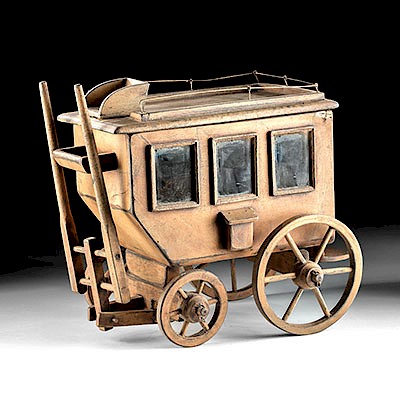Aztec Volcanic Stone Weasel w/ Von Winning Report
Lot 86
About Seller
Artemis Gallery
686 S Taylor Ave, Ste 106
Louisville, CO 80027
United States
Selling antiquities, ancient and ethnographic art online since 1993, Artemis Gallery specializes in Classical Antiquities (Egyptian, Greek, Roman, Near Eastern), Asian, Pre-Columbian, African / Tribal / Oceanographic art. Our extensive inventory includes pottery, stone, metal, wood, glass and textil...Read more
Estimate:
$4,000 - $6,000
Absentee vs Live bid
Two ways to bid:
- Leave a max absentee bid and the platform will bid on your behalf up to your maximum bid during the live auction.
- Bid live during the auction and your bids will be submitted real-time to the auctioneer.
Bid Increments
| Price | Bid Increment |
|---|---|
| $0 | $25 |
| $300 | $50 |
| $1,000 | $100 |
| $2,000 | $250 |
| $5,000 | $500 |
| $10,000 | $1,000 |
| $20,000 | $2,500 |
| $50,000 | $5,000 |
| $100,000 | $10,000 |
| $200,000 | $20,000 |
About Auction
By Artemis Gallery
Nov 14, 2019
Set Reminder
2019-11-14 10:00:00
2019-11-14 10:00:00
America/New_York
Bidsquare
Bidsquare : Ethnographic | Tribal | American Frontier
https://www.bidsquare.com/auctions/artemis-gallery/ethnographic-tribal-american-frontier-4634
Featuring Pre-Columbian, Tribal / Oceanic, Spanish Colonial, historical examples from the Spanish, Mexican, and American frontiers, fossils, and more. All items offered for sale have been legally acquired, are legal to sell and are guaranteed to be as described or your money back. Artemis Gallery info@artemisgallery.com
Featuring Pre-Columbian, Tribal / Oceanic, Spanish Colonial, historical examples from the Spanish, Mexican, and American frontiers, fossils, and more. All items offered for sale have been legally acquired, are legal to sell and are guaranteed to be as described or your money back. Artemis Gallery info@artemisgallery.com
- Lot Description
Pre-Columbian, Mexico, Aztec Empire, ca. 1400 to 1521 CE. A fascinating grey volcanic stone carving of a crouching weasel, probably a representation of a long-tailed weasel, an animal that would have been known to inhabitants of central Mexico as a fierce hunter. The animal is lifelike, crouched as if ready to spring, either playfully or hunting. Its legs are coiled beneath its body, its tail wrapped around one black leg, its ears flat and triangular nose on the ground. The eyes are gently indented. Did they once have inlays or some other colored stone? This delightful sculpture would have graced an architectural feature. Size: 8.45" L x 4.25" W x 4.65" H (21.5 cm x 10.8 cm x 11.8 cm)
The Aztecs, like most pre-industrial societies, had a close relationship with animals and the natural landscape. Many of their cultural metaphors, adages, and omens were based on the behavior of animals, so that, for example, it was believed to be bad luck if a weasel crossed one's path. Animals were also bound up with magic, which could manifest itself as medicine - for example, Aztec people with epilepsy were asked to eat the brain of a fox or a weasel as a cure. Finally, weasels themselves could also be manifestations of magic - commoner wizards and magicians, the kind of people from whom someone could buy a small cure or call upon for household protection, was believed to be able to shapeshift into a turkey, a weasel, or a dog (whereas high ranking wizards could transform into coyotes or other fierce beasts).
Provenance: private Arcadia, California, USA collection, acquired over twenty years ago; comes with Von Winning report dated 1973
All items legal to buy/sell under U.S. Statute covering cultural patrimony Code 2600, CHAPTER 14, and are guaranteed to be as described or your money back.
A Certificate of Authenticity will accompany all winning bids.
We ship worldwide and handle all shipping in-house for your convenience.
#136380Wear on surface commensurate with age, with some pitting and light encrustation.Condition
- Shipping Info
-
All shipping is handled in-house for your convenience. Your invoice from Artemis Gallery will include shipping calculation instructions. If in doubt, please inquire BEFORE bidding for estimated shipping costs for individual items.
-
- Buyer's Premium



 EUR
EUR CAD
CAD AUD
AUD GBP
GBP MXN
MXN HKD
HKD CNY
CNY MYR
MYR SEK
SEK SGD
SGD CHF
CHF THB
THB















